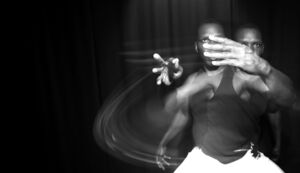Space Harmony
space harmony
give relevant entry points.
From his Rosicrucian roots, dancer and choreographer Rudolf Laban created a movement praxis he called choreutics, which reflected what he articulated as space harmony. It is based on patterns of rhythm and balance that can be perceived everywhere in nature, including in human anatomy. Laban saw spatial patterns in the pathways of human movement and recognized in these the shapes of the Platonic Solids. Expressive human movement closely aligned with the inclinations in the structure of these regular polyhedral forms.
Laban took the spatial patterns that follow the Platonic Solids as forms to be actualized through human movement. He came to articulate specific Movement Scales: a series of patterned movement sequences that performers can repeat; moving through these pathways in a predefined way. These Scales linked the natural spatial gestures of human bodies that move along all directions and inclinations to the directions of the vertices of a platonic shape. Following these movement Scales opens up the body in space and also enlarges spatial awareness. It balances the body spatially and aesthetically. This is why this spatial practice is called space harmony.
At the same time, Rudolf Laban further investigated the nature of harmonious and efficient effort and coined the term eukinetics to address this study. eukinetics is a combination of two Greek root words—
‘eu’ meaning beautiful or harmonious and ‘kinetikos’ meaning movement. During the final two decades of his career in England, Laban’s interest and analysis shifted from creative and artistic movement to a broader concern with human movement in general.
In parallel to this he dropped the exotic word eukinetics and adopted the more common English term, ‘effort.’ The term addresses an abstracted concept, that when studied always needs to be understood in context. How effort is situated can be seen by answering a number of key questions. Whose efforts are we referring to? What are the reasons for this effort? Where and when does the effort take place? How does the effort take place? Why is this effort performed at all? Working with these and other questions in his investigation of effort led Laban to identify two main domains of action, both of which give rise to practices of ever refining mastering of spatial experience and spatial skill. One group is comprised of goal-oriented actions such as sports↵ and political and commercial endeavours. The attention of the bodies engaged in these actions is focused on the exterior and their spatial skills are applied to navigating and strategizing the use of space outside the body. The other group of actions is directed towards expressive goals such as artistic gestures, religious and cultural performance. The attentions of bodies engaged in these kinds of actions is focused internally, and their skills are applied in charting an outward expression of their inscapes. This second group of actions also leads to and mobilizes self-knowledge.
Performing and experiencing the return beat provides the metaphysical context for both forms of effort, where both the navigated inscapes of the percipient practitioner, and their outward expressions of goal-oriented action are spatial, and the extra internal dimensions of self-awareness can lead to self-knowledge. As such, the return beat facilitates a wave-field for human activity.
